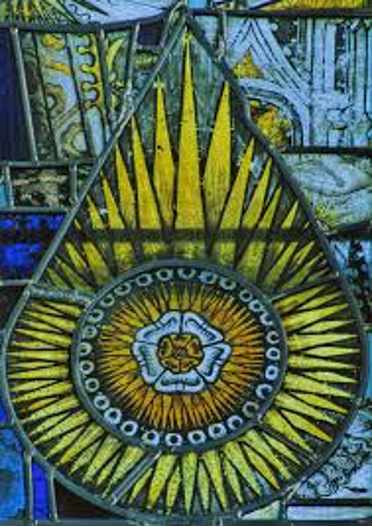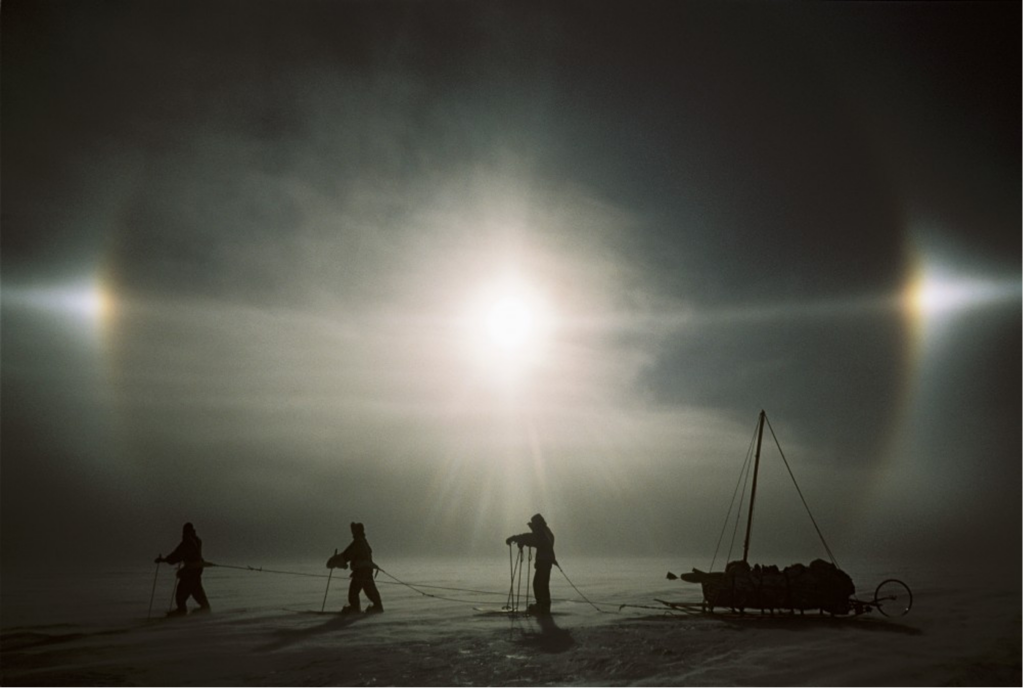The adjacent suns
(Poet's title: Die Nebensonnen)
Set by Schubert:
D 911/23
[October 1827]
Part of Winterreise, D 911
Drei Sonnen sah ich am Himmel stehn,
Hab lang und fest sie angesehn.
Und sie auch standen da so stier,
Als wollten sie nicht weg von mir.
Ach, meine Sonnen seid ihr nicht,
Schaut andern doch ins Angesicht!
Ach, neulich hatt’ ich auch wohl drei:
Nun sind hinab die besten zwei.
Ging nur die dritt’ erst hinterdrein,
Im Dunkeln wird mir wohler sein.
I saw three suns standing in the sky,
I looked at them carefully for a long time;
And they also stood there staring,
As if they did not want to leave me.
Alas, you are not my suns!
Go and look somebody else in the face!
Alas, I also recently had three myself:
Now the best two have set.
If only the third would now follow them!
I shall be better off in the dark.
All translations into English that appear on this website, unless otherwise stated, are by Malcolm Wren. You are free to use them on condition that you acknowledge Malcolm Wren as the translator and schubertsong.uk as the source. Unless otherwise stated, the comments and essays that appear after the texts and translations are by Malcolm Wren and are © Copyright.
☙
Themes and images in this text:
RICHARD (third son of the Duke of York)
See how the morning opes her golden gates
And takes her farewell of the glorious sun.
How well resembles it the prime of youth,
Trimmed like a younker prancing to his love.
EDWARD (eldest son of the Duke of York)
Dazzle mine eyes, or do I see three suns?
RICHARD
Three glorious suns, each one a perfect sun,
Not separated with the racking clouds
But severed in a pale clear-shining sky.
See, see, they join, embrace and seem to kiss,
As if they vowed some league inviolable.
Now are they but one lamp, one light, one sun:
In this, the heaven figures some event.
EDWARD
'Tis wondrous strange, the like yet never heard of.
I think it cites us, brother, to the field,
That we, the sons of brave Plantagenet,
Each one already blazing by our meeds,
Should, notwithstanding, join our lights together
And over-shine the earth, as this the world.
Whate'er it bodes, henceforward will I bear
Upon my target three fair-shining suns.
William Shakespeare, King Henry VI Part 3 (1592) Act II Scene 1 (edited by John D. Cox and Eric Rasmussen for The Arden Shakespeare)
Shakespeare learned of the phenomenon of the three suns from Edward Hall’s chronicle of the Wars of the Roses (1548), where it is explained that Edward, the son of the Duke of York, used an image of the ‘sun in his full brightness’ as his heraldic device on his coat of arms because ‘the sun (as some write) appeared . . . like iii. suns, and suddenly joined all together in one’. Shakespeare then dramatised this by playing with the pun on sun / son and saw that the phenomenon of the three suns uniting could be connected with the three sons of the Duke of York. At the beginning of Richard III, the sequel to King Henry VI Part 3, Richard (the third son) watches the coronation of his elder brother as Edward IV and declares:
Now is the winter of our discontent
Made glorious summer by this son [sun?] of York.
The rest of the play shows Richard’s rise to power as King Richard III and the way in which he extinguished the light of the other two suns / sons.

Wilhelm Müller knew Shakespeare’s work well and could have taken the basic idea for ‘Die Nebensonnen‘ from it, but the sun / son pun was not available for use in German. Nor did he have any use for the political associations of the image in Shakespeare (alliance, betrayals, power struggles etc). He seemed to agree, with Richard, that ‘In this, the heaven figures some event’, but what he focuses on is the idea of three suns setting.
I believe the phenomenon of three suns can be explained scientifically, but here it would seem to be allegorical. The distinguished musicologist A. H. Fox-Strangeways suggested that Faith, Hope and Life are represented – a poetic conclusion and in the context of the cycle an acceptable one. Most certainly the suns of Faith and Hope exist no more for our afflicted wanderer, all that is left to him is Life and that is a stuff he would readily do without.
Gerald Moore, The Schubert Song Cycles London 1975 page 165
The mystery of Müller’s poem, much commented on – what are the three suns? – is at one and the same time all mystery and no mystery at all. The wanderer’s three suns are the girl’s eyes and the sun itself. He has lost his love and would be better off dead. That is the bald and clumsy reading of the image. Its very baldness, though, its slight clunkiness, which may be a fault in Müller’s poetry, is what makes us seek for more, for deeper significance, which is its virtue here.
Ian Bostridge, Schubert’s Winter Journey. Anatomy of an Obsession Faber & Faber 2015 pp. 459-460
☙

Sundogs, sometimes called Sun Dogs, Parhelia or Mock Suns, are with the 22º halo, the most frequent of the ice halos. They are most easily seen when the sun is low. Look about 22° (outstretched hand at arm's length) to its left and right and at the same height. When the sun is higher they are further away. Each 'dog' is red coloured towards the sun and sometimes has greens and blues beyond. Sundogs can be blindingly bright, at other times they are a mere coloured smudge on the sky. They are visible all over the world and at any time of year regardless of the ground level temperature. In Europe and North America one will be seen on average twice a week if searched for. http://www.atoptics.co.uk/halo/parhelia.htm
http://www.atoptics.co.uk/halo/parhelia.htm
https://twitter.com/hashtag/parahelion
https://en.wikipedia.org/wiki/Sun_dog
http://ww2010.atmos.uiuc.edu/(Gh)/guides/mtr/opt/ice/sd.rxml
For an interesting correspondence concerning observations of parahelia at the same time (1735-1736) in Peterborough, England and Wittenberg, Saxony, see https://royalsocietypublishing.org/doi/pdf/10.1098/rstl.1737.0010, https://royalsocietypublishing.org/doi/pdf/10.1098/rstl.1737.0011 and https://royalsocietypublishing.org/doi/pdf/10.1098/rstl.1739.0078
☙
Original Spelling and notes on the text Die Nebensonnen Drei Sonnen sah' ich am Himmel stehn, Hab' lang' und fest sie angesehn; Und sie auch standen da so stier, Als wollten1 sie nicht weg von mir. Ach, m e i n e Sonnen seid ihr nicht! Schaut Andern doch in's Angesicht! Ach2, neulich hatt' ich auch wohl drei: Nun sind hinab die besten zwei. Ging' nur die dritt' erst hinterdrein! Im Dunkeln wird mir wohler sein. 1 Schubert changed 'könnten' (they could not) to 'wollten' (they did not want to) 2 Scubert changed 'Ja' (yes) to 'Ach' (alas)
Confirmed by Peter Rastl with Gedichte aus den hinterlassenen Papieren eines reisenden Waldhornisten. Herausgegeben von Wilhelm Müller. Zweites Bändchen. Deßau 1824. Bei Christian Georg Ackermann, page 102; and with Deutsche Blätter für Poesie, Litteratur, Kunst und Theater. Herausgegeben von Karl Schall und Karl von Holtei. Breslau 1823, bei Graß, Barth und Comp. No. XLII. 14. März 1823, page 165.
First published in Deutsche Blätter (see above) as no. 6 of the installment of Die Winterreise. Lieder von Wilhelm Müller.
To see an early edition of the text, go to page 102 Erstes Bild 116 here: https://download.digitale-sammlungen.de/BOOKS/download.pl?id=bsb10115225


